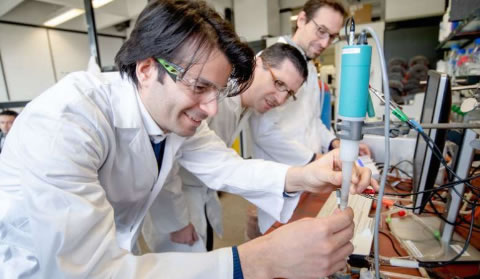Iodide salt can stabilize biocatalyst of fuel cell
Oxygen is the biggest enemy of energy conversion biocatalyst. The protective film can shield them-but can only add other ingredients: iodide salt.
Contrary to theoretical predictions, even under the protective film, oxygen will deactivate the biocatalyst in a short time, thereby achieving energy conversion. The Resolv excellence cluster research team at Ruhr University (RUB) in Bochum discovered the following reasons: hydrogen peroxide formed on the protective film. Adding iodide salt to the electrolyte can prevent this from happening and greatly extend the life of the catalyst. A team of Prof. Nicolas Plumeré from Resolv, Dr. Erik Freier from the Leibniz Institute of Analytical Sciences and Prof. Wolfgang Lubitz from the Max Planck Institute for Chemical Energy Conversion in Dortmund reported their findings in Nature Communications .

Disable in seconds
There are many types of biological and biologically inspired catalysts, and their catalytic performance is close to that of precious metal catalysts. However, they are not widely used in energy conversion processes. The reason is their instability. Nicolas Plumeré explained: “Some of the most active small molecule conversion catalysts associated with sustainable energy systems are so sensitive to oxygen that they will be completely inactivated within seconds after being exposed to oxygen.â€
The research team recently discovered that films with redox activity can protect biologically inspired organisms and even biocatalysts such as hydrogenases. Theoretical models predict that the protection of oxygen should continue indefinitely. However, in experiments, this protection has only been effective for a few hours so far. "This contradicts our theoretical calculations, and even considering the lifetime of the same catalyst in an oxygen-free environment cannot be explained," Plumeré said. The latter lasts for six weeks and the turnover remains unchanged.
Combination of methods
This led the researchers to conclude that either the protective mechanism of oxygen is not known, or other harmful processes will occur in addition to being deactivated by oxygen. In order to investigate this, they combined multiple methods to enable them to examine in detail what happened in the protected layer. The combination of a confocal fluorescence microscope conducted by Erik Freier in the laboratory and coherent anti-Stokes Raman scattering, and an electrochemical analysis used to analyze the protective matrix show that the protective process leads to the accumulation of hydrogen peroxide, which promotes the catalytic The destruction of the membrane.
Researchers have shown that even if the iodized salt is exposed to high oxygen concentrations, the decomposition of hydrogen peroxide and iodide salt will prolong the half-life of the hydrogenase used for hydrogenation up to a week at a constant turnover. "Overall, our data confirms the theory that redox membranes deactivate oxygen-sensitive catalysts completely without direct oxygen deactivation," Plumeré concluded. "However, it is important to suppress the production of hydrogen peroxide to achieve complete protection against oxidative stress."
The researchers said: "Our work shows that a simple strategy for adding iodized salt to the electrolyte is sufficient to significantly reduce the deactivation rate of the biocatalyst." They believe that this will enable other electrocatalytic processes to be widely implemented in practical applications. This also includes energy conversion processes, such as the production of solar fuel by reducing carbon dioxide and the electrosynthesis of fine or alkaline chemicals such as ammonia.
A sampling valve is a type of valve used in process industries that allows taking a representative portion of a fluid (gases, liquids, fluidized, solids, or slurries)Sanitary sample valve is also called sample cock valve, sampling valve, including stainless steel Sanitary Sampling Valves, Food Grade Sample Valves, Hygienic Sample Valves,Kaysen supply supperial quality stainless steel sanitary sampling valves, food grade sample valves, hygienic sample valves in SS304, SS316, SS316L materials, size from 1/2"-4", DN15-DN100, connection types contains weld, clamp, thread types,etc
Sanitary Sampling Valves Specification:
Material: SS304, SS316 or SS316L
Connection Standard: 3A, DIN, SMS, ISO, IDF, RJT, BPE
Port size: DN15-DN100, 1/4"-4"
Connection type: weld, clamp, thread
Gasket material: EPDM, PTFE, VMQ. All are FDA approved.
Pressure: 0-6bar
Temperature range: -10℃ to 120℃(EPDM), -40℃-130℃(PTFE)
Sanitary Sampling Valves
Sanitary Sampling Valves,Food Grade Sample Valves,Hygienic Sample Valves
Kaysen Steel Industry Co., Ltd. , https://www.chinasanitaryvalve.com